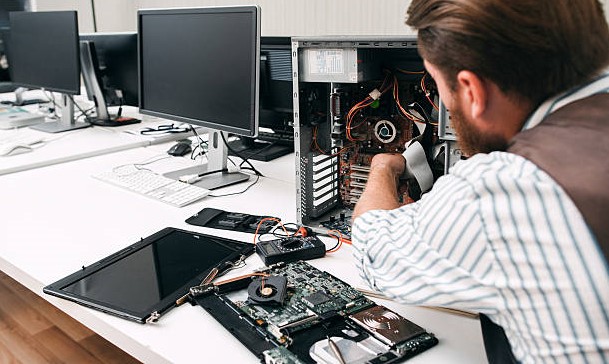
Are you wondering why other computer repair businesses are ahead of you?
We all know how intense the competition is in the computer repair industry. Given the high volume of repairs arising from a wide array of computer brands and models, you need the capabilities to handle the orders. As your customers are not willing to wait for you to give them a quote or complete the repair, your operations must always be up to the mark. For this reason, there has been an increase in the adoption of computer repair management software.
In this post, we discuss the outcome of incorporating these modern-day solutions in a computer repair business.
The Complex Process of Computer Repair
A Wide Variety of Devices and Issues
The wide range of devices and issues that arise regularly contributes to the complexity of the computer repair sector. Computers are available in a wide variety of forms, sizes, brands, and models, each having special features and setups. Technicians need to be knowledgeable about a variety of systems, including hybrid devices like tablets and Windows- and Mac-based PCs, desktops, and gaming laptops.
When you take into account all of the possible problems, this complexity increases. A hardware issue could be caused by a broken screen, malfunctioning RAM, or a defective hard drive. Software problems could also be the culprit, such as viruses, corrupted operating systems, or background tasks that impede performance. It takes a thorough understanding of the hardware and software components as well as troubleshooting experience to diagnose these issues effectively.
Continuous Improvements in Technology
Technology is developing at a dizzying rate. The computer repair sector needs to be up to date with security patches, software updates, and constantly changing hardware. Tech businesses introduce new models with upgraded components every year, which presents new difficulties for repair specialists.
If a technician hasn’t kept up with the latest advances, they can find it difficult to handle the hardware intricacies of a 2024 model, even if they are skilled at servicing laptops from 2015.
Just as quickly as new hardware is developed, so too does software. Applications add new functionality that may not work with other operating systems or necessitate specialist maintenance methods while operating systems themselves undergo frequent updates. Continuous learning is required for a computer repair business to stay current, which adds to the already difficult nature of the industry.
Also, here’s how you can successfully win chargeback disputes for your repair shop.
Differentiating Between Customer Expectations
Another level of complexity to the industry is the expectations of the consumer. The complexities of computer repair may be beyond the comprehension of the typical user. But they anticipate easy, affordable, and long-lasting fixes.
Because most consumers depend so heavily on their gadgets, prompt repair timeframes are essential. Furthermore, it’s important to make sure that no data is lost during restoration because clients frequently take great pride in their data.
The Industry’s Competition
Another complicating element is the competitive nature of the computer repair sector. This industry is home to a wide range of companies, from bigger, more well-known chains to neighborhood mom-and-pop repair shops. Customers may be erratic when there are so many options accessible.
If consumers believe one repair company offers quicker service or a better deal, they can choose to switch.
It might be difficult to strike a balance between providing great service, keeping costs down, and guaranteeing quick turnaround times. While prices should be competitive enough to draw clients, low prices run the danger of reducing earnings. The corporation must pay skilled experts, make tool and software investments, and keep up a functioning workplace all at the same time—all while making sure there is a sufficient profit margin to support future expansion.
Automation in Top Computer Repair Companies
Many of the top computer repair companies have adopted automation as a way to keep ahead of these difficulties. Automation improves client experiences, optimizes workflows, and streamlines procedures. Strategic utilization lowers human error, manual labor, and operating expenses while increasing business efficiency.
Automating Troubleshooting and Diagnostics
Automating diagnostic procedures is among the biggest advantages of automation for the computer repair sector. In the past, troubleshooting may take hours, needing a specialist to manually test different parts and look into any software problems. Modern diagnostic software makes a lot of this process automated.
These instruments can carry out thorough system inspections, looking for possible problems in the hardware and software. Automated diagnostics give specialists comprehensive reports that identify issue areas and offer solutions. With the use of this technology, troubleshooting may be completed much more quickly, freeing up technicians’ time to concentrate on repairs rather than spending hours trying to solve problems.
Key Takeaways
The computer repair sector will always be difficult. If anything, it’s probably going to get worse as technology develops. Nevertheless, companies can take on this complexity head-on by utilizing automation. Businesses can increase customer interactions, handle administrative work, expedite diagnostics, and guarantee a consistent supply of critical parts by implementing automated operations.
The top computer repair companies are aware that while automation can handle many of the monotonous duties that would otherwise slow down operations, human experience is still vital.